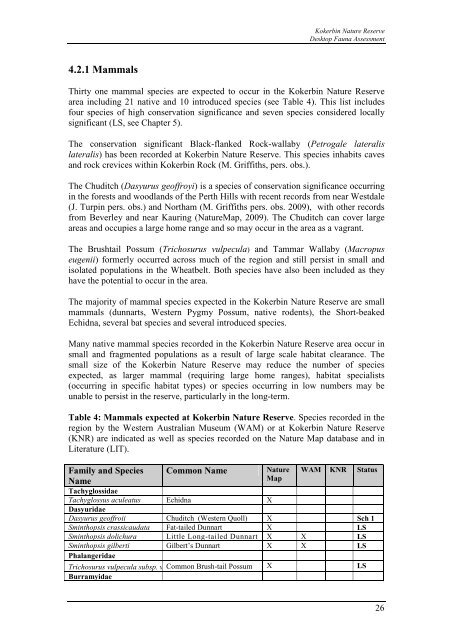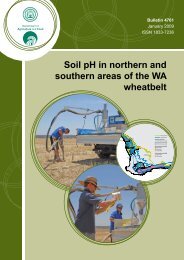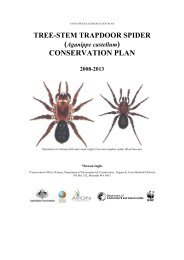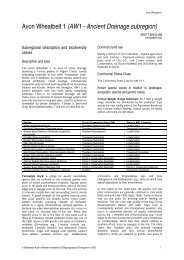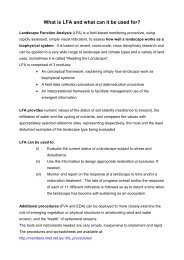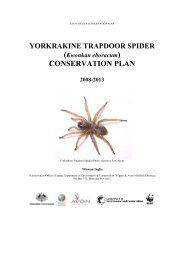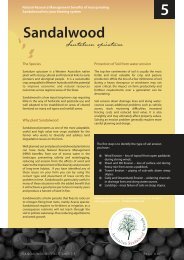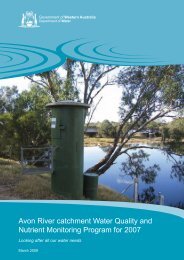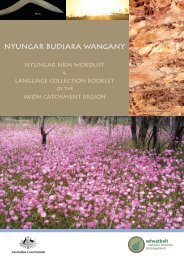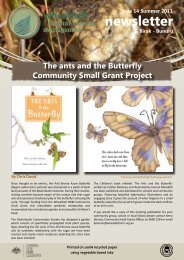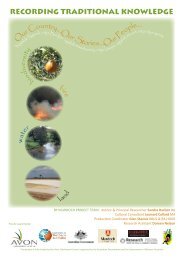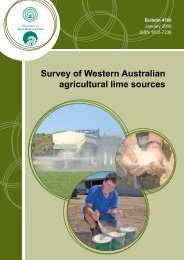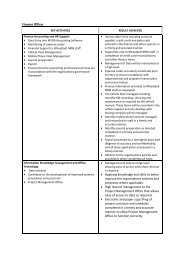Kokerbin Nature Reserve Desktop Fauna ... - Wheatbelt NRM
Kokerbin Nature Reserve Desktop Fauna ... - Wheatbelt NRM
Kokerbin Nature Reserve Desktop Fauna ... - Wheatbelt NRM
You also want an ePaper? Increase the reach of your titles
YUMPU automatically turns print PDFs into web optimized ePapers that Google loves.
<strong>Kokerbin</strong> <strong>Nature</strong> <strong>Reserve</strong><br />
<strong>Desktop</strong> <strong>Fauna</strong> Assessment<br />
4.2.1 Mammals<br />
Thirty one mammal species are expected to occur in the <strong>Kokerbin</strong> <strong>Nature</strong> <strong>Reserve</strong><br />
area including 21 native and 10 introduced species (see Table 4). This list includes<br />
four species of high conservation significance and seven species considered locally<br />
significant (LS, see Chapter 5).<br />
The conservation significant Black-flanked Rock-wallaby (Petrogale lateralis<br />
lateralis) has been recorded at <strong>Kokerbin</strong> <strong>Nature</strong> <strong>Reserve</strong>. This species inhabits caves<br />
and rock crevices within <strong>Kokerbin</strong> Rock (M. Griffiths, pers. obs.).<br />
The Chuditch (Dasyurus geoffroyi) is a species of conservation significance occurring<br />
in the forests and woodlands of the Perth Hills with recent records from near Westdale<br />
(J. Turpin pers. obs.) and Northam (M. Griffiths pers. obs. 2009), with other records<br />
from Beverley and near Kauring (<strong>Nature</strong>Map, 2009). The Chuditch can cover large<br />
areas and occupies a large home range and so may occur in the area as a vagrant.<br />
The Brushtail Possum (Trichosurus vulpecula) and Tammar Wallaby (Macropus<br />
eugenii) formerly occurred across much of the region and still persist in small and<br />
isolated populations in the <strong>Wheatbelt</strong>. Both species have also been included as they<br />
have the potential to occur in the area.<br />
The majority of mammal species expected in the <strong>Kokerbin</strong> <strong>Nature</strong> <strong>Reserve</strong> are small<br />
mammals (dunnarts, Western Pygmy Possum, native rodents), the Short-beaked<br />
Echidna, several bat species and several introduced species.<br />
Many native mammal species recorded in the <strong>Kokerbin</strong> <strong>Nature</strong> <strong>Reserve</strong> area occur in<br />
small and fragmented populations as a result of large scale habitat clearance. The<br />
small size of the <strong>Kokerbin</strong> <strong>Nature</strong> <strong>Reserve</strong> may reduce the number of species<br />
expected, as larger mammal (requiring large home ranges), habitat specialists<br />
(occurring in specific habitat types) or species occurring in low numbers may be<br />
unable to persist in the reserve, particularly in the long-term.<br />
Table 4: Mammals expected at <strong>Kokerbin</strong> <strong>Nature</strong> <strong>Reserve</strong>. Species recorded in the<br />
region by the Western Australian Museum (WAM) or at <strong>Kokerbin</strong> <strong>Nature</strong> <strong>Reserve</strong><br />
(KNR) are indicated as well as species recorded on the <strong>Nature</strong> Map database and in<br />
Literature (LIT).<br />
Family and Species<br />
Name<br />
Common Name<br />
<strong>Nature</strong><br />
Map<br />
WAM KNR Status<br />
Tachyglossidae<br />
Tachyglossus aculeatus Echidna X<br />
Dasyuridae<br />
Dasyurus geoffroii Chuditch (Western Quoll) X Sch 1<br />
Sminthopsis crassicaudata Fat-tailed Dunnart X LS<br />
Sminthopsis dolichura Little Long-tailed Dunnart X X LS<br />
Sminthopsis gilberti Gilbert’s Dunnart X X LS<br />
Phalangeridae<br />
Trichosurus vulpecula subsp. v Common Brush-tail Possum X LS<br />
Burramyidae<br />
26


